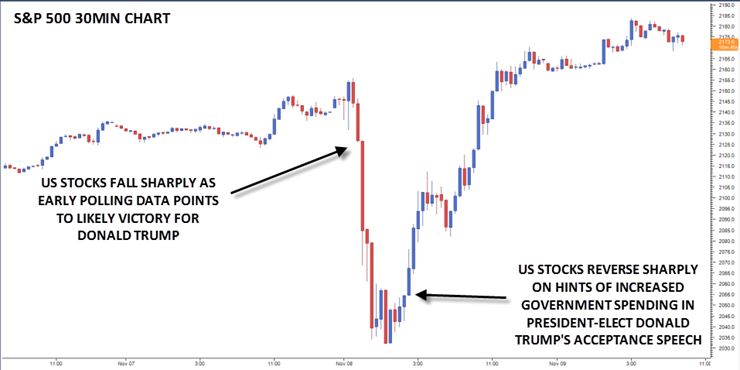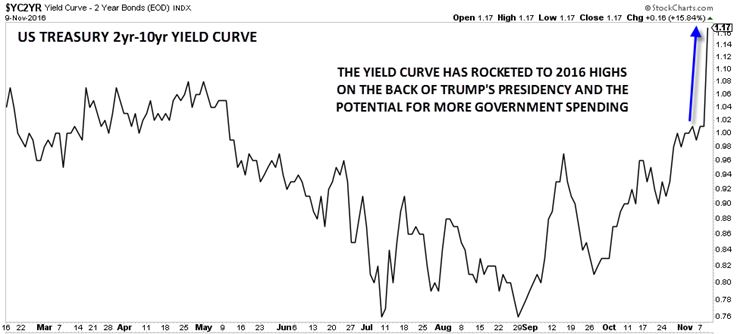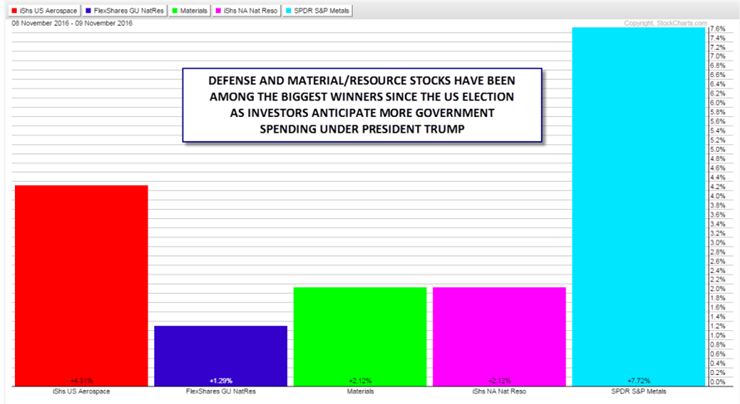Before the election, there were dire predictions about what a Donald Trump presidency may mean for the US stock market, with some prognosticators calling for a -7% (seven sigma!) drop on the first day. Those grim forecasts appeared on point on election night, when US markets were halted limit down (-5%) at one point overnight.
However, by the time the sun rose on Wednesday (and yes, the sun did rise as always), markets had done a 180° and were actually trading higher on the day. Yesterday, the Dow Jones Industrial Average closed at all-time record high.
So What Changed?
People who have followed Trump's political ascendancy won't be surprised to hear that what changed was, well, "The Donald" himself.
In his late night acceptance speech, the bombastic political chameleon pivoted away from his vitriolic "throw Hillary in jail" rhetoric to a more presidential posture, magnanimously complementing Clinton on a well-run campaign and her service to the country.
More importantly for investors, he immediately highlighted the need for more government spending:
We are going to fix our inner cities and rebuild our highways, bridges, tunnels, airports, schools, hospitals. We're going to rebuild our infrastructure, which will become, by the way, second to none. And we will put millions of our people to work as we rebuild it.
For those unfamiliar with American politics, the idea that a Republican president would put more government spending at the top of his agenda is anathema to the party's traditional "smaller government" stance.
"We Are All Keynesians Now" (Milton Friedman)
In case you nodded off in your Economics 101 class, Keynesian Economics is the theory that the government should increase spending (and cut taxes) to stimulate a slow economy, and conversely, should cut spending (and raise taxes) when the economy is at risk of overheating.
In recent years, central bankers have been among the biggest proponents of increased fiscal spending (i.e. Keynesianism); take this excerpt from Fed Chair Janet Yellen's speech from this year's Jackson Hole symposium as an example:
Beyond monetary policy, fiscal policy has traditionally played an important role in dealing with severe economic downturns. A wide range of possible fiscal policy tools and approaches could enhance the cyclical stability of the economy...many possibilities in this area are worth considering, including...promoting capital investment [government infrastructure spending]
Market Reaction: Bonanza!
Many market participants view fiscal spending as the "missing piece" to the economic puzzle, and the prospect of an injection of government spending into the economy has prompted traders to go crazy. The chart below shows that the S&P 500 reversed sharply on the back of president-elect Trump's hint of additional government spending:

Source: Faraday Research
Expectations of higher inflation (driven by government spending) under a Trump presidency has also caused the 2-year and 10-year Treasury yield curve to explode higher:

Source: Stockcharts.com
In layman's terms, this means traders think inflation will rise. Short-term interest rates (which have moved comparatively little) are controlled by the Federal Reserve, whereas longer-term interest rates (which have rocketed higher) are driven by the market's inflation expectations. Trump's stated policies to restrict immigration, increase tariffs, and of course, enact new fiscal stimulus through tax cuts and infrastructure spending should all increase price pressures in the coming years.
So What's Next?
We believe that this trend may have legs.
Moving forward, the continuation of this "reflation trade" would see an extension of the market moves we've seen over the last 36 hours: US stocks may extend their current rally, the dollar could remain strong on expectations of faster-than-anticipated interest-rate hikes next year and US bonds may struggle as traders fear higher interest rates (and inflation) in the future.
On a more granular level, one way to play the "Keynesian Reflation" trade within the stock market would be to buy materials and defense stocks, which stand to be the big beneficiaries of more government spending and have been among the strongest performers since the election:

Source: Stockcharts.com
In the coming days, we'll continue to explore the implications of Donald Trump's election on markets, including financial stocks and gun manufacturers, as well as offer ways to take advantage of the resulting market opportunities - stay tuned.
